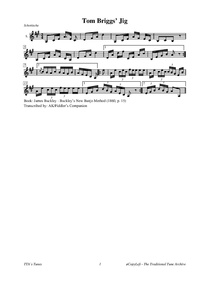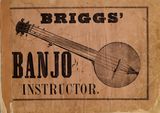Template:Pagina principale/Vetrina: Difference between revisions
No edit summary |
No edit summary |
||
| Line 1: | Line 1: | ||
{{SheetMusic | {{SheetMusic | ||
|f_track= | |f_track=Tom Brigg's Jig.mp3 | ||
|f_pdf= | |f_pdf=Tom Brigg's Jig.pdf | ||
|f_artwork= | |f_artwork=Briggs' banjo instructor.jpg | ||
|f_tune_name= | |f_tune_name=Tom Briggs' Jig | ||
|f_track_title= | |f_track_title=Tom Briggs' Jig | ||
|f_section=abc | |f_section=abc | ||
|f_played_by=[https:// | |f_played_by=[https://www.youtube.com/channel/UCULm3jROXEj83hMZCFllrcw Jordi Savall] | ||
|f_notes= | |f_notes= Briggs' banjo instructor. | ||
|f_caption= | |f_caption=Briggs' banjo instructor (music) : containing the elementary principles of music, together with examples and lessons, ... to which is added a choice collection of pieces, numbering over fifty popular dances, polkas, melodies, &c. &c., many of which have never before been published. Composed and arranged expressly for this work. | ||
|f_source=[https:// | |f_source=[https://www.youtube.com/watch?v=Gb1J11feTbc Youtube] | ||
|f_pix=420 | |f_pix=420 | ||
|f_picpix=200 | |f_picpix=200 | ||
|f_article=[[ | |f_article=[[Tom Briggs' Jig | '''Tom Briggs' Jig''']] | ||
Tom Briggs (c. 1824/25-1854) learned to play the banjo from one of the first blackface minstrel musicians, Bill Whitlock. He played with Wood's Minstrels and performed in England in 1849. | |||
He traveled to California with E.P. Christy's Minstrels in the mid-1850's, via the Gulf of Mexico and the Isthmus of Panama, to tour the gold camps and to perform in San Francisco. However, soon after opening night in that city he succumbed to typhoid fever or tuberculosis contracted in Panama. His banjo tutor, '''Briggs' Banjo Instructor''' (Oliver Ditson, Boston 1855) was completed by his friend, minstrel James Buckley. | |||
Tom Briggs, according to Edward Le Roy Rices’ '''Monarchs of Minstrelsy''' (New York, 1911) was: | |||
<blockquote> | |||
''...one of the earliest and greatest banjo performers in minstrelsy; when he first went'' | |||
''on the stage, in the early 40’s, he travelled under the name of Fluter. He invented the'' | |||
''banjo thimble in 1848 [used for rapid tremolo picking], and it came into general use three'' | |||
''years later. He was the first to do the bell chimes [i.e. harmonics] , and gave imitations'' | |||
''of a horserace on the banjo. He played successful engagements in the 40’s and 50’s with'' | |||
''Wood’s Minstrels, likewise Buckley’s Serenaders. September 20 1854, he left New York'' | |||
''with E.P. Christy’s Minstrels to play an engagement in San Francisco; he contracted an'' | |||
''illness on the way, and was unable to play. Tom Briggs died in San Francisco October 23, '' | |||
''1854; aged 30 years.'' (p. 46) | |||
</blockquote> | |||
}} | }} | ||
Revision as of 09:42, 21 October 2023

Played by: Jordi Savall
Source: Youtube
Image: Briggs' banjo instructor.

Tom Briggs (c. 1824/25-1854) learned to play the banjo from one of the first blackface minstrel musicians, Bill Whitlock. He played with Wood's Minstrels and performed in England in 1849.
He traveled to California with E.P. Christy's Minstrels in the mid-1850's, via the Gulf of Mexico and the Isthmus of Panama, to tour the gold camps and to perform in San Francisco. However, soon after opening night in that city he succumbed to typhoid fever or tuberculosis contracted in Panama. His banjo tutor, Briggs' Banjo Instructor (Oliver Ditson, Boston 1855) was completed by his friend, minstrel James Buckley.
Tom Briggs, according to Edward Le Roy Rices’ Monarchs of Minstrelsy (New York, 1911) was:
...one of the earliest and greatest banjo performers in minstrelsy; when he first went on the stage, in the early 40’s, he travelled under the name of Fluter. He invented the banjo thimble in 1848 [used for rapid tremolo picking], and it came into general use three years later. He was the first to do the bell chimes [i.e. harmonics] , and gave imitations of a horserace on the banjo. He played successful engagements in the 40’s and 50’s with Wood’s Minstrels, likewise Buckley’s Serenaders. September 20 1854, he left New York with E.P. Christy’s Minstrels to play an engagement in San Francisco; he contracted an illness on the way, and was unable to play. Tom Briggs died in San Francisco October 23, 1854; aged 30 years. (p. 46)
...more at: Tom Briggs' Jig - full Score(s) and Annotations
X:1 T:Tom Briggs' Jig M:2/4 L:1/8 R:Schottische B:James Buckley - Buckley's New Banjo Method (1860, p. 15) Z:AK/Fiddler's Companion K:A V:1 clef=treble name="1." [V:1] A,C/E/ A/>E/ C|DF/A/ d2|A,C/E/ A/F/ E/C/|B,CB,z| A,C/E/ A/F/ C/A,/|DF/A/ d2|1 D/A/ d/f/ C/E/ A/c/|B,/E/G/B/ Az:| |2{d}c/B/A/c/ B/A/G/B/|A/F/E/C/ A,||:e|A/e/ (3c/e/c/ (3f/e/e/ e/e/|A/e/ (3c/e/c/ (3c/B/G/ E/B/| A/e/ (3c/e/c/ (3f/e/e/ e/e/|1 E/G/B/ (3d/B/G/ (3A/E/C/ A,z:|2 (3E/G/B/ (3d/B/G/ AA,||
